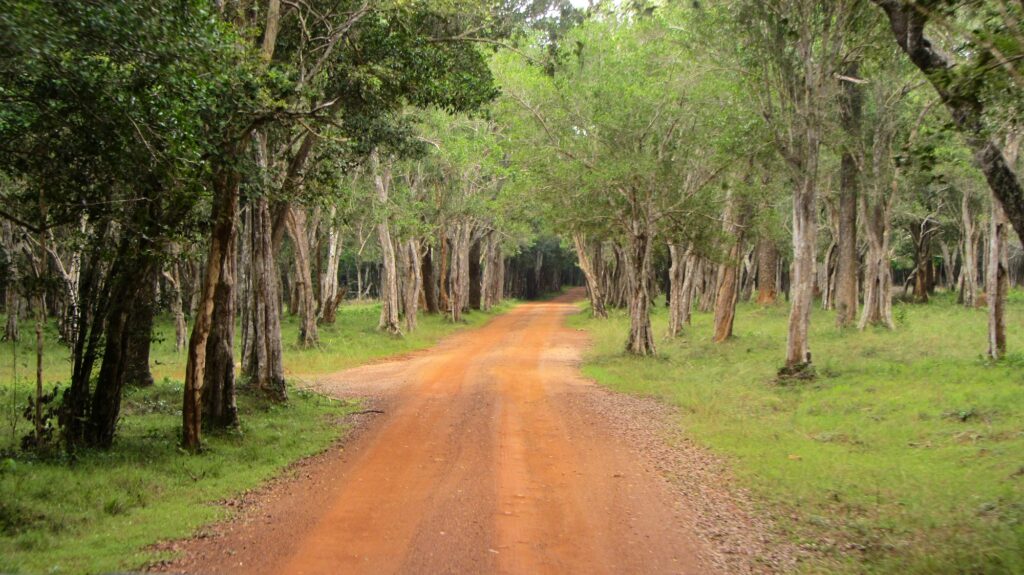
Wilpattu is a biodiversity hotspot and one of the best places in Sri Lanka to spot the elusive Sri Lankan leopard (Panthera pardus kotiya), a subspecies found only on the island.
Leopards: While sightings are not as frequent as in Yala, Wilpattu is believed to have a healthy leopard population.
Elephants: Several herds roam the park, especially near the lakes during the dry season.
Other Mammals: Includes sloth bears, spotted deer, sambar deer, wild boars, jackals, and water buffalo.
Birds: Over 200 species including painted storks, eagles, owls, and peacocks.
Reptiles & Amphibians: Crocodiles, monitor lizards, pythons, and various amphibians can also be spotted.
Wilpattu offers jeep safaris led by experienced guides who help track wildlife and share knowledge about the park’s ecosystem. The safaris usually run in the early morning and late afternoon, which are the best times for animal sightings.
Unlike some of the busier parks, Wilpattu provides a quieter, more serene safari experience, ideal for those seeking a deeper connection with nature.
Declared a national park in 1938, Wilpattu has long been a vital sanctuary for Sri Lanka’s wildlife. However, due to past civil unrest in the northern region, the park remained closed for several years and was reopened to the public in 2010. Since then, conservation efforts have helped the park recover and flourish.
Wilpattu plays a crucial role in preserving endangered species and maintaining ecological balance in Sri Lanka’s dry zone.
Wilpattu is reachable by road from major cities:
From Colombo: approximately 4–5 hours by car
From Anuradhapura: approximately 1 hour
From Kalpitiya or Puttalam: approximately 2 hours
Its proximity to cultural landmarks like Anuradhapura and Mihintale makes it an ideal addition to a heritage and wildlife tour.
Wilpattu National Park – The Land of Lakes and Leopards
Located in the northwestern region of Sri Lanka, Wilpattu National Park is the largest and one of the oldest national parks in the country. Known for its unique landscape of natural lakes and its rich wildlife, Wilpattu offers a truly wild and less-crowded safari experience for those looking to explore Sri Lanka’s untamed side.
Wilpattu spans across the North Western and North Central Provinces, covering an area of approximately 1,317 square kilometers. It lies about 30 km west of Anuradhapura and around 180 km from Colombo, making it accessible yet remote enough to feel like a true wilderness.
Wilpattu is named after its “Willus” – natural, shallow rainwater-filled lakes that are scattered throughout the park. These lakes create a distinctive ecosystem, supporting a wide variety of wildlife and adding to the park’s scenic beauty.
The terrain includes dense scrub forests, open grasslands, and wetlands, providing diverse habitats for both flora and fauna.
Wilpattu is a biodiversity hotspot and one of the best places in Sri Lanka to spot the elusive Sri Lankan leopard (Panthera pardus kotiya), a subspecies found only on the island.
Leopards: While sightings are not as frequent as in Yala, Wilpattu is believed to have a healthy leopard population.
Elephants: Several herds roam the park, especially near the lakes during the dry season.
Other Mammals: Includes sloth bears, spotted deer, sambar deer, wild boars, jackals, and water buffalo.
Birds: Over 200 species including painted storks, eagles, owls, and peacocks.
Reptiles & Amphibians: Crocodiles, monitor lizards, pythons, and various amphibians can also be spotted.
Wilpattu offers jeep safaris led by experienced guides who help track wildlife and share knowledge about the park’s ecosystem. The safaris usually run in the early morning and late afternoon, which are the best times for animal sightings.
Unlike some of the busier parks, Wilpattu provides a quieter, more serene safari experience, ideal for those seeking a deeper connection with nature.
Declared a national park in 1938, Wilpattu has long been a vital sanctuary for Sri Lanka’s wildlife. However, due to past civil unrest in the northern region, the park remained closed for several years and was reopened to the public in 2010. Since then, conservation efforts have helped the park recover and flourish.
Wilpattu plays a crucial role in preserving endangered species and maintaining ecological balance in Sri Lanka’s dry zone.
Wilpattu is reachable by road from major cities:
From Colombo: approximately 4–5 hours by car
From Anuradhapura: approximately 1 hour
From Kalpitiya or Puttalam: approximately 2 hours
Its proximity to cultural landmarks like Anuradhapura and Mihintale makes it an ideal addition to a heritage and wildlife tour.
The park is open year-round, but the best time to visit is during the dry season (February to October), when wildlife gathers around the Willus and visibility is at its best.
+94702768807
Seelananda Road, Kaluwamodara, Aluthgama, Sri Lanka
Design By : viowebdesign.lk
Copyright © 2025 kanitours.com All Rights Reserved